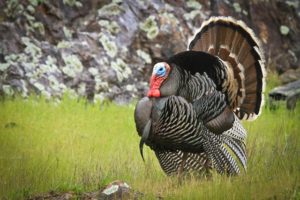Turkey hunting safeguards
Turkey Hunters: Be Safe!
Every fall, thousands of hunters take to the woods and fields in New England in an effort to bag a wild turkey. Turkeys can be very quiet and have excellent eye sight, and hunters are in camouflage when hunting. This creates a risk which periodically comes across our claims desk of injury as a result of being “mistaken for game.” Courtesy of the Minnesota Department of Natural Resources (DNR), here are some safety tips for turkey hunting:
OFFENSIVE SAFEGUARDS
To avoid costly errors in judgment, the DNR recommends the following self-imposed rules:
- Wait to see the entire bird
- Assume anything that moves is another hunter until you can positively identify it
- Don’t let excitement, nerves or competitiveness cloud your judgment;
- Guard against premature closure [ie, shooting too early] by reminding yourself that the chance of bagging a gobbler in uncertain circumstances isn’t worth the risk of injuring or killing another hunter
- Don’t point your gun or slip off the safety until you have positively identified your target.
DEFENSIVE SAFEGUARDS
To avoid becoming the victim of a turkey hunting accident, observe the following rules:
- Cover your entire head and body with camouflage; an exposed hand or face can be mistaken for part of a turkey
- Don’t wear or carry anything colored red, white, blue, brown or black, colors that are associated with turkey gobblers. Wear a hunter-orange vest and hat when moving through the woods
- Wrap the vest around the tree where you plan to call turkeys, which will warn other hunters of your presence
- When you kill a turkey, immediately cover it with a camouflage bag or wrap it in a hunter-orange cloth before carrying it out of the woods
- Never hunt in areas that other hunters may be using; they could mistake you for game or unknowingly catch you in their line of fire
- If you see another hunter, shout to identify yourself but never wave because movement could draw fire from a careless shooter
- Exercise extreme caution in using turkey decoys because they may draw fire; place decoys so they are not visible to other hunters in the line of sight that would put you in someone else’s line of fire
- Select a spot where you can see any hunter who might approach
- When calling, sit with your back against a tree or other solid object that will protect your blind side from injury
- Don’t try to stalk a turkey, because you could be stalking another hunter, who might shoot you by mistake.




